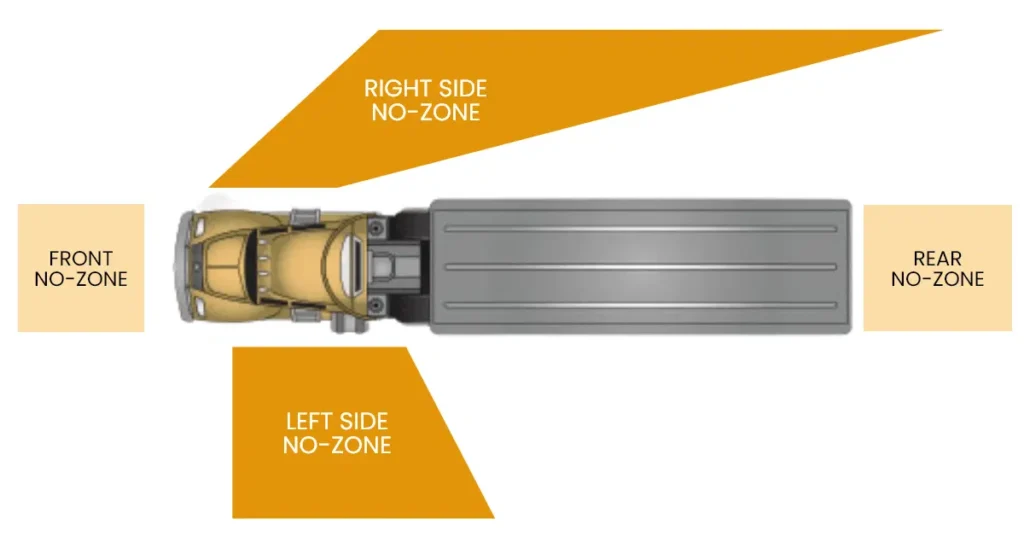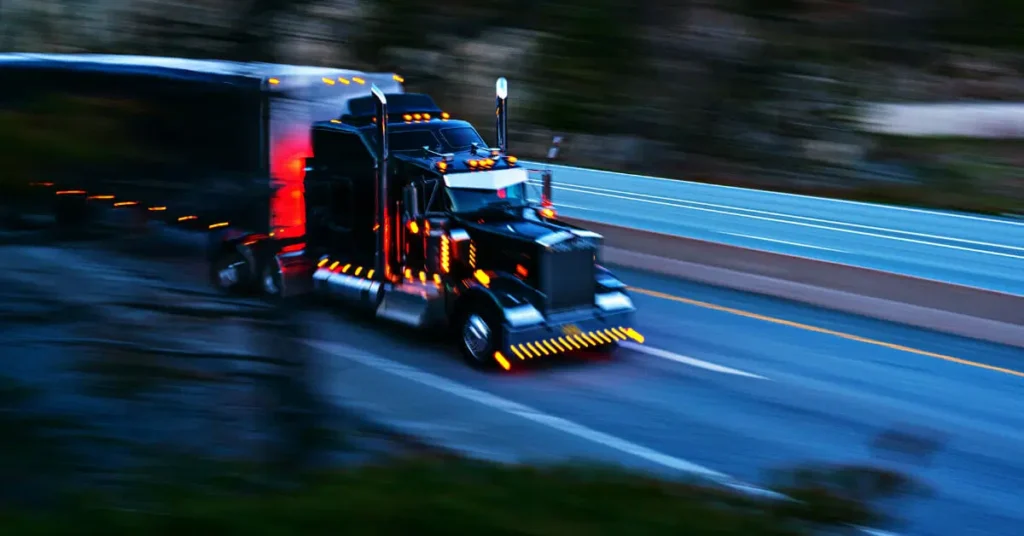Since large trucks are much bigger than other vehicles, truck drivers sit higher than the other motorists, making people assume they have a bird’s eye view of everyone around them and the highway.
However, semi-truck drivers have limited visibility in reality. Since tractor-trailers are enormous, truck drivers can’t see all around.
More specifically, semi-trucks have significant blind spots where a car or another small truck will seemingly “disappear” from the truck driver’s view.
These blind spots are called “no zones” because it’s dangerous to remain in them while driving near a semi-truck. Simply put, the blind spots in commercial trucks are called no-zones since the driver cannot see you in them.
Here’s more about the four no zones of a semi-truck and how to share the road with a semi-truck!

The Four Major No-Zones Of A Semi Truck
It’s tricky to know if you’re in the no-zone of a truck while driving through the busy streets of America, but there’s one way to know for sure.
If you see the truck driver’s face in their side-view mirrors, the driver can, too, and you’re not in their blind spot. But if you can’t see the truck driver, they may not know about you driving beside or behind them.
Rule Of Thumb: Look for the driver’s face in the side mirror.
Does the fear of truck accidents make you wonder about the safety precautions in your truck? Learn whether semi-trucks have airbags.
It’s important to understand the four major no-zones below to dive safely near a truck.
1. The Front No-Zone
At times, semi-trucks move slowly, which can annoy other drivers. If you’ve spent a significant amount of time behind a semi-truck, you know how tempting it is to overtake when gaps are visible. But cutting in front of a truck isn’t wise because they have a blind spot that can extend up to 20 feet in front of the truck’s tractor.
Semi-truck drivers can’t see vehicles in this area, making it life-threatening if they suddenly halt. Generally, you should allow at least one car length per 10 mph you’re traveling (50 mph equals five car lengths). Hence, never cut in front of a truck and instantly slow down.
Did You Know: If you can see the entire front of the vehicle in your rearview mirror, you’re traveling at a safe distance from the semi.

2. The Rear No-Zone
Semi-trucks also contain a big blind spot behind the truck’s semi-trailer. The rear no-zone is one of the large blind spots in a tractor-trailer, ranging from 30 feet behind the trailer to 200 feet.
You shouldn’t follow a truck too closely, as you may be in the driver’s blind spot. Moreover, tailgating is poor driver behavior because truckers don’t enjoy the benefit of a rear-view mirror, as the trailer blocks the same.
Following too closely behind a truck can cause underride if the truck stops suddenly, which happens when a vehicle slides under the trailer, dismantling the car’s top and resulting in catastrophic injury and death.
3. The Right No-Zone
The right no-zone is the largest blind spot for a semi-truck driver. In addition, it can extend over two lanes of traffic. This blind spot begins at the truck’s passenger side door and expands outward to cover the lanes adjacent to the trailer.
It’s critical to never pass a truck on the right side. As mentioned, if you can’t see the driver’s face in his side mirror, it’s reasonable to assume that he can’t see you. Consequently, if you want to pass, do it from the left.
Similarly, drivers should avoid driving on the truck’s right, even on large-lane highways.

4. The Left No-Zone
Apart from no-zones directly in front and back of the truck, there are blind spots on both sides. Unlike the right no-zone, the left no-zone is the smallest, but it’s still hazardous to drive there.
If you wish to pass the truck, ensure you do it quickly so you can get back into the driver’s visibility range. Although the driver has more visibility on the left than on the right, it’s safer to avoid this no-zone.
Bonus Read: Do you know the difference between a semi-truck and a tractor-trailer?
How To Stay Safe Around Trucks And Buses? (Avoiding Truck Accidents & No Zones)
As a passenger vehicle driver, you can follow these tips to stay safe on the road and around a truck’s no-zone:
- You can pass any vehicle on the left, but take extra care while passing semi-trucks on the right side.
- Before changing lanes, make sure it’s safe to do so. Avoid switching lanes in a hurry when other vehicles are moving side-to-side.
- It’s important to stay out of a semi truck’s blind spots.
- When you notice a truck driver making a turn, give them space and time without putting your vehicle in danger.
- Use your signals at every turn and lane change while also paying attention to the other drivers’ signals.




